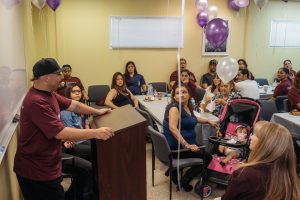October is Domestic Abuse Awareness Month, but Elaine DeSimone deals with this issue every day.
DeSimone is Outptient/Substance Use Disorder Program Director at Clínica Romero, where she oversees a program that has Anger Management/Domestic Violence Classes to perpetrators and victims, including youth ages 12-18.
“Anger management is a component of domestic violence,” DeSimone says. “Anger is where it stems from.”
Clínica Romero offers three domestic violence groups in English and Spanish, Monday through Friday, at its Alvarado and Marengo sites: in the morning, noon and night.
“We want to make it accesible to them,” DeSimone says.
Many of the people in the classes are referred there because they have cases with the Department of Children and Family Services (DCFS), and often their children have been taken away because there is substance abuse and domestic violence in the home.
Often, such problems are hidden until the authorities get involved.
“It always starts small, with grooming,” DeSimone says of domestic violence, which is not necessarily just hitting, but can be emotional and financial abuse.
“Months go by of putting this person down, and then a slap may happen,” she adds.
The perpetrator will ask for forgiveness and things may be OK for several months before another violent episode happens.
“The girl has her own issues and ignores all the red flags there,” DeSimone says. “They say, ‘I can fix him, he’s not going to do that to me,’” but it slowly escalates.
TREATED ‘WORSE THAN A DOG’
“Maria”, a Mexican woman in her 40s, exemplifies this behavior.
For over two decades, she was married to a husband 20 years her senior who beat her, belittled her and made her feel “worse than a dog,” she says.
She was 15 when her husband visited her small town in the state of Jalisco and swept her off her feet. They married in Mexico and the abuse began the same day of their marriage.
“I made him dinner and when I served it, he threw it away and said he didn’t like it,” Maria recalls.
Years later, he brought her to the United States, where the land of opportunities turned into a nightmare. They lived with her husband’s family and he never took her out.
The man had a short temper and anything that upset him turned into a shove, a push, name calling and/or a slap. After her daughter was born, her husband never again slept with her, telling her “she smelled.”
Much later she would find out he had a separate family.
Maria eventually had a nervous breakdown and attempted suicide by ingesting pills. She didn’t tell the doctors the true reason for the suicide attempt.
“When I was released from the hospital, he told me ‘you know I can put you away any time I want.’ That scared me,” she says.
When she was 11, her daughter told a teacher at her school what happened in the house and police were called.
Maria was taken to the police station and told she was safe. But she had no money and nowhere to go. Another mom from her daughter’s school let her stay in a small mobile home on her property and slowly Maria began to get her life in order.
She got a divorce and her husband eventually died of cancer. She took care of him in his final days, when she also confronted him for the abuse, though he never apologized.
“THERE’S ALWAYS A STIGMA”
DeSimone has seen these type of cases countless of times.
And she’s not surprised that many keep it hidden.
“There’s always a stigma. We’re taught to not share our stuff with anybody. That what happens at home stays at home.
“You don’t talk about that stuff and that’s when the problem starts,” says DeSimone, who also witnessed domestic abuse in her home growing up.
“My dad was very much an alcoholic as well,” says DeSimone, who grew up in New York and is of Italian background.

Cutting that cycle is what DeSimone and her team try to do in the program at Clínica Romero. The programs may last 26 weeks (if they are referred by DCFS) and up to 52 weeks (when they are referred by the courts).
CUTTING THE CYCLE
Cutting that cycle is what DeSimone and her team try to do in the program at Clínica Romero.
The programs may last 26 weeks (if they are referred by DCFS) and up to 52 weeks (when they are referred by the courts).
For the women (often the victims, though at times they may be the perpetrators as well), it’s about becoming educated about the signs to watch out for and “learning the whys and that it’s not their fault,” she says.
For the men, (often the perpetrators, but sometimes victims as well), it starts with admitting their abuse.
“At first, the perpetrators say they can’t do this and that they didn’t do anything,” she explains. “As they start to trust us, and the people in the group, they start admitting things in the group. That’s a win.”
“It’s about having an epiphany. You have to talk about what happens to get better.”
The classes touch a number of subjects, including conflict resolution with spouses, how to stop anger (i.e. go take a walk and to remember the consequences that they’ve faced for their abuse).
But above all, it’s about teaching perpetrators and victims a simple fact: “Beatings are not normal.”
For anybody in a domestic abuse situation, DeSimone stresses that they are not alone and there is help at Clínica Romero.
“A lot of people don’t know where to start. Here they have a safe space and that they have someone to talk to and a place to start,” she says.
RESOURCES
Clínica Romero
(323) 987-1034
National Domestic Violence Hotline
1 (800) 799-7233


